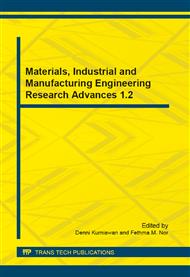[1]
Li, C. S. Cluster center initialization method for K-means algorithm over data sets with two clusters, Procedia Engineering. (2011) 324-328.
DOI: 10.1016/j.proeng.2011.11.2650
Google Scholar
[2]
Everitt, B., Landau, S., Lesse, M. and Stahl, D. Cluster Analysis 5th Edition. John Wiley & Sons. (2011).
Google Scholar
[3]
Larose, D. T. Discovering Knowledge in Data. John Wiley & Sons. (2005).
Google Scholar
[4]
Erisoglu, M., Cailis, N., Servi, T., Erisoglu, U. and Topaksu, M. A new algorithm for initial cluster centers in K-means algorithm, Pattern Recognition Letters. (2011) 1701-1705.
DOI: 10.1016/j.patrec.2011.07.011
Google Scholar
[5]
Cao, F., Liang, J. and Jiang, G. An initialization method for the K-Means algorithm using neighborhood model, Computers and Mathematics with Applications. (2009) 474-483.
DOI: 10.1016/j.camwa.2009.04.017
Google Scholar
[6]
Mac Queen, J. Some methods for classification and analysis of multivariate observations, Proc. 5th Berkeley Symp. Math. Stat and Prob. (1967) 281-297.
Google Scholar
[7]
Scripps, J. and Tan, P.N. Constrained overlapping clusters: minimizing the negative effects of bridge-nodes, Statistical Analysis and Data Mining. (2010) 20-37.
DOI: 10.1002/sam.10066
Google Scholar
[8]
Pen, J.M., Lozano, J. and Larraga, P. An empirical comparisson of four initialization methods for the K-means algorithm, Pattern Recognition Letters. (1999) 1027-1040.
DOI: 10.1016/s0167-8655(99)00069-0
Google Scholar
[9]
Kumar, A.S. Knowledge Discovery Practices and Emerging Applications of Data. Idea Group Inc. (2011).
Google Scholar
[10]
Laan, M., Pollard, K. and Bryan, J. A new partitioning around medoids algorithm, Journal of Statistical Computation and Simulation. 73 (2003) 575-584.
DOI: 10.1080/0094965031000136012
Google Scholar
[11]
Feng, M. and Wang, Z. A genetic K-means clustering algorithm based on the optimized initial cluster, Computer and information science. 4 (2011).
Google Scholar
[12]
Coley, D.A. An Introduction to Genetic Algorithms for Scientists and Engineers. World Scientific. (1999).
Google Scholar
[13]
Mitchell, M. An Introduction to Genetic Algorithms. MIT Press. (1998).
Google Scholar
[14]
Chang, D.X., Zhang, X.D. and Zheng, C.W. A genetic algorithm with gene rearrangement for K-means clustering, Pattern Recognition. (2009) 1210-1222.
DOI: 10.1016/j.patcog.2008.11.006
Google Scholar


